Women in Thai Cuisine (Part 1): The Classical Era
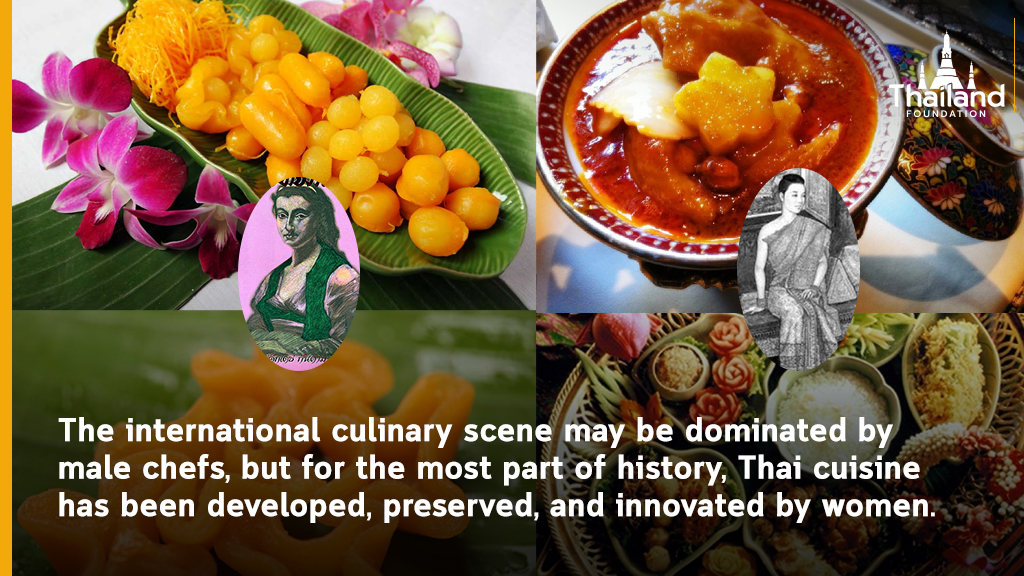
If I ask you to name a few world’s famous chefs right now, you’ll probably think of male chefs who run cooking shows or write best-selling cookbooks, and other faces you often see on mainstream media. However, if you shift the focus to your family, the most fundamental unit of society, your first memories of food probably revolve around the women in your house, either your mother or grandmother. After all, the very food source of every baby is its mother, isn’t it?
The Thai food scene nowadays may be teeming with talented male chefs (whom we are proud of by all accounts). Still, we are proud to say that for the most part of history, Thai culinary culture has been developed, preserved, and innovated by women. In light of the celebrations of the achievements and contributions of women in the month of International Women’s Day, we invite you to explore the stories of influential women in Thai cuisine and their flavorful contributions through this article series that will piece together the evolution of Thai food, from the classical era, the era of change, to the modern era.
The Queendom of the Kitchen
Thai women have always been taking a major role in Thai food. On television, female chefs may be working their way to gain more representation, but in the real world, female chefs throughout the country sit gracefully on their thrones. If you notice the names of restaurants, dessert shops, or famous food brands, especially those of ancient recipes, you will find countless names that begin with “mae” which means “mother.” To give you a few examples, we have Mae Pranom (dipping sauce), Mae Kim Lung (Thai custard), Mae Lamiad (Thai custard), Sam Mae Krua (canned mackerel), Mae Puay Lang (rice cracker), Mae Buay (Thai sponge cake), Mae Pom (Thai cotton candy or Roti Saimai ), Mae Pranee (Thai-styled fried dough), and so on. The last two brands even received the “Bib Gourmand Award” which is given to food establishments that offer exceptionally good food at reasonable prices). Basically, almost every famous Thai traditional dessert brand starts with the “mae,” we dare you to try them all.
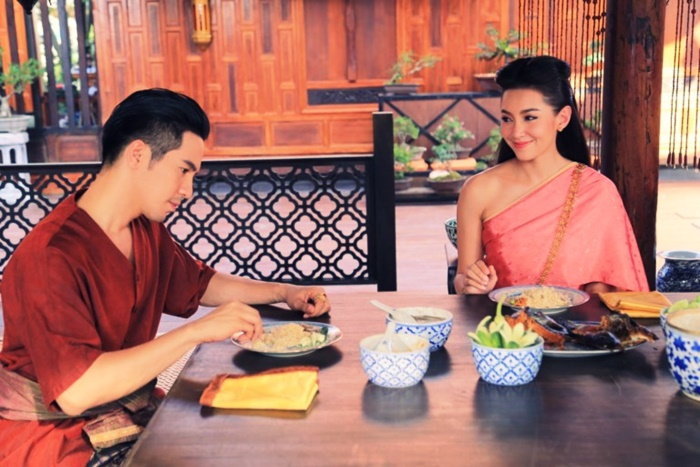
[cr. Sanook]
In addition, the outstanding cooking skills of Thai women are the charm that captivates men’s hearts. A Thai idiom “Sanay Plai Chawak” precisely describes this tasty attraction. Sanay [เสน่ห์] means charm while plai [ปลาย] means the edge or end, and chawak [จวัก] means a ladle. Altogether, it is translated as “the charm at the ladle’s end.” In the old days, parents who were looking for a wife for their son would prefer a young woman who was an amazing cook. This value is communicated through many popular Thai folk songs. For example, in The Goddess of Thai Sarongs[1] (Thep Thida Pha Sin), a song by Seree Rungsawang says that “If you are looking for a good woman, look at the mother…………Every time she pounds chili paste, the frequency of the pounding sound is so powerful that the rice field is shaken.” This part of the lyrics also shows that the mother is responsible for training her daughter to cook and look after the family.
“Sum Rub” – Compassion on the Table
When the food is ready, we bring it out to the dining room. Unlike the western culture in which the order of dishes begins with an entrée, followed by a main course, and ended with a dessert, the Thai culture has what is known as a sum rub [สำรับ]. Literally, sum rub means dinnerware, but in the real life usage, it refers to a Thai set meal.
Thais live in extended families, with many generations sharing the same roof. We love to eat in, and therefore, mealtime is our quality time. To ensure that all generations of the family – children, adults, and seniors – can equally enjoy the meals, we prepare a balanced sum rub that contains all flavors and textures. In other words, there must be 1) a spicy dish and fresh vegetables for adults who can handle strong flavors and have healthy teeth to crunch raw greens, 2) mild-flavored and soft-textured food for grandparents who are less tolerant to spices, and 3) a sugar-added dish for children and adults to alternate with spicy food. A real sum rub may have a deep fried fish (soft and tender meat), tom yum koong (spicy), clear soup (mild broth for the elderly and children), sweet pork cutlets (for children and adults) and fresh and boiled vegetables with chili paste dip (for everyone and for kids to familiarize themselves with spicy food).
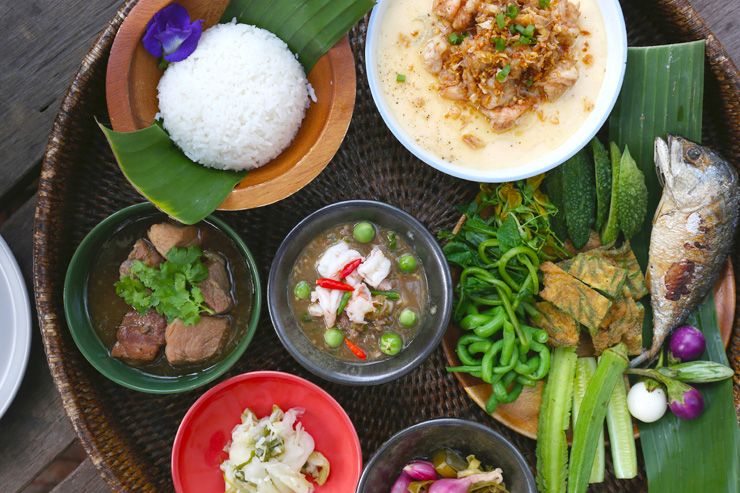
[cr. Post Today]
Through the sum rub, the lady of the house exercises her compassion and love for her family members.
Ladies in the Royal Court
After the founding of Rattanakosin in 1782, the Grand Palace became the center of fine arts and culture, including culinary art, known as the royal cuisine. Generally, the royal cuisine is similar to commoner cuisine, but more refined in flavors and aesthetics. The taste must be mellow, smooth and balanced. Strong flavors are avoided. The appearance must be exquisitely beautiful. The cooking techniques and presentation must be meticulous so that the royal family could savor the meals while keeping their graceful manners.
Some of the important female figures in charge of royal cookery in the early Rattanakosin period were Her Royal Highness Princess Srisudarak, sister of King Rama I, who supervised food preparation in the royal kitchen, and Queen Sri Suriyendra of King Rama II, who oversaw the cuisine for King Rama II to King RamaVI.
Celebrated recipes during the reign of King Rama I included “kaeng ron khanom jin namya” (the rice noodles with hot curry) invented by Concubine Waen from Vientiane. During the annual merit making ceremony of the Temple of the Emerald Buddha, King Rama I ordered to cook khanom jin namya to feed thousands of monks every day. Concubine Waen, praised for her excellent hot curry, was trusted by the king to prepare the offering. She also invented a snack called “khai hong” (swan’s eggs). It is said that, King Rama I wished to have monitor lizard’s eggs, but no one could find the eggs since it was out of season. Concubine Waen then created a dessert that looked like the lizard’s eggs, made from glutinous rice flour mixed with sweet potato stuffed with salted green beans. It was named “khai hong” instead of “khai hia” (monitor lizard’s eggs) for politeness because “hia” is a swearword in Thai.
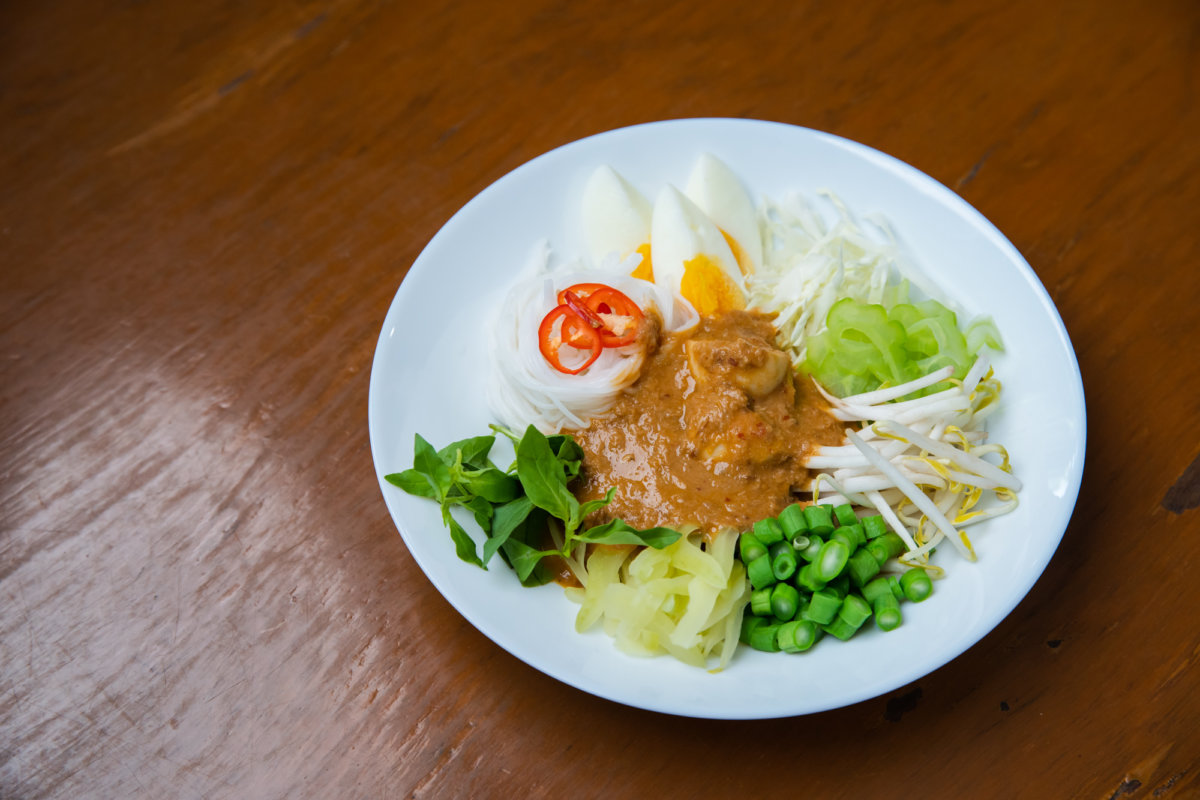
Khanom Jin Namya [cr. Happy Fresh]
Lady Thongyu invented “khanom khang khao” (bat-shaped snack), a savory dessert made of shrimp and coconut filling wrapped in triangular dough which looks like a bat spreading its wings. The stuffed dough is fried until golden crispy and enjoyed with dipping sauce.
Princess Ku, also known as Lady Wat Pho, was the aunt of King Rama II, and cooked delectable Thai dumplings with pork filling. Her dough folding skill was unmatched. Her dumplings looked delicate with sheer and thin flour, revealing the pork filling inside. The edges of the wrapping dough were sharp like the folding of a royal woman’s robe.
Diversity of Thai Cuisine in Ayutthaya – Early Rattanakosin Era
Culturally, food is an edible proof of the history and richness of a country. The abundance of natural resources in Thailand is obvious to everyone including Jeremias Van Vliet, a Dutch merchant of the East India Company, who wrote in his journal that “Siam is blessed with nature’s bounty. People can subsist on domestic products and fruits… They can live very well without having to rely on the produce of other countries…”
During the transition from the Ayutthaya era, to the Thon Buri era, and finally to the Rattanakosin era, the palace welcomed elite ladies from many territories, not only Thais, but also princesses from the satellite or subject states and allies, such as Cambodia, China, Chiang Mai (north of Thailand), Nakhon Si Thammarat (south of Thailand), and Muslim states. The different backgrounds of these ladies enriched the royal and common food scene with diversity and uniqueness. Not to mention the Chinese, Indian, and European influence that entered Thailand through trade and introduced multiculturalism to Thai food. Another piece of evidence from a foreigner’s diary stated that the food offered to foreign guests by the Thai royal court was not Thai, but foreign food, be it Chinese or European or Arabian dishes. We may assume that the kitchen of the Thai royal court must have boasted an international working environment with cooks from many nationalities rubbing shoulders.
The food mentioned above reflects this diversity very well. For example, khanom khang khao is believed to have a Persian inspiration due to its resemblance to samosas or curry puffs. The Thai dumplings and noodles are influenced by China. We add sugar to our snacks like the Arabs, and use egg and milk in sweets like the Westerners.
Important Individuals
- Thao Thong Kip Ma (ท้าวทองกีบม้า)
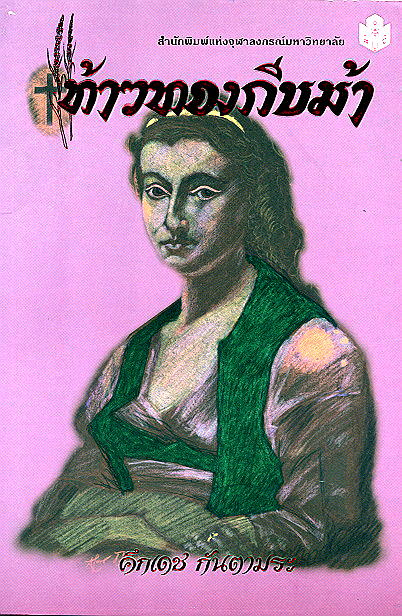
Artistic imagination of Thao Thong Kip Ma [cr. MThai]
Marie Guimar, also known by her Thai noble title – Thao Thong Kip Ma, is celebrated as the Queen of Thai Sweets. Due to very few written documents about her background, there is still uncertainty about her lineage. However, the most accepted theory is that she was mixed Japanese, Portuguese, and Bengali and moved to Ayutthaya in the 17th century. Her family settled down in a Japanese community along the Chaophraya River across from the Portuguese community. Later, she was married to Constantine Phaulkon, a Greek adventurer who became a counsellor of King Narai. As a wife of King’s favorite, Marie Guimar showcased her cooking talents by hosting special guests including merchants, priests and ambassadors. Finally, she came to work in the palace as Thao Thong Kip Ma to develop and supervise the preparation of Thai dessert.
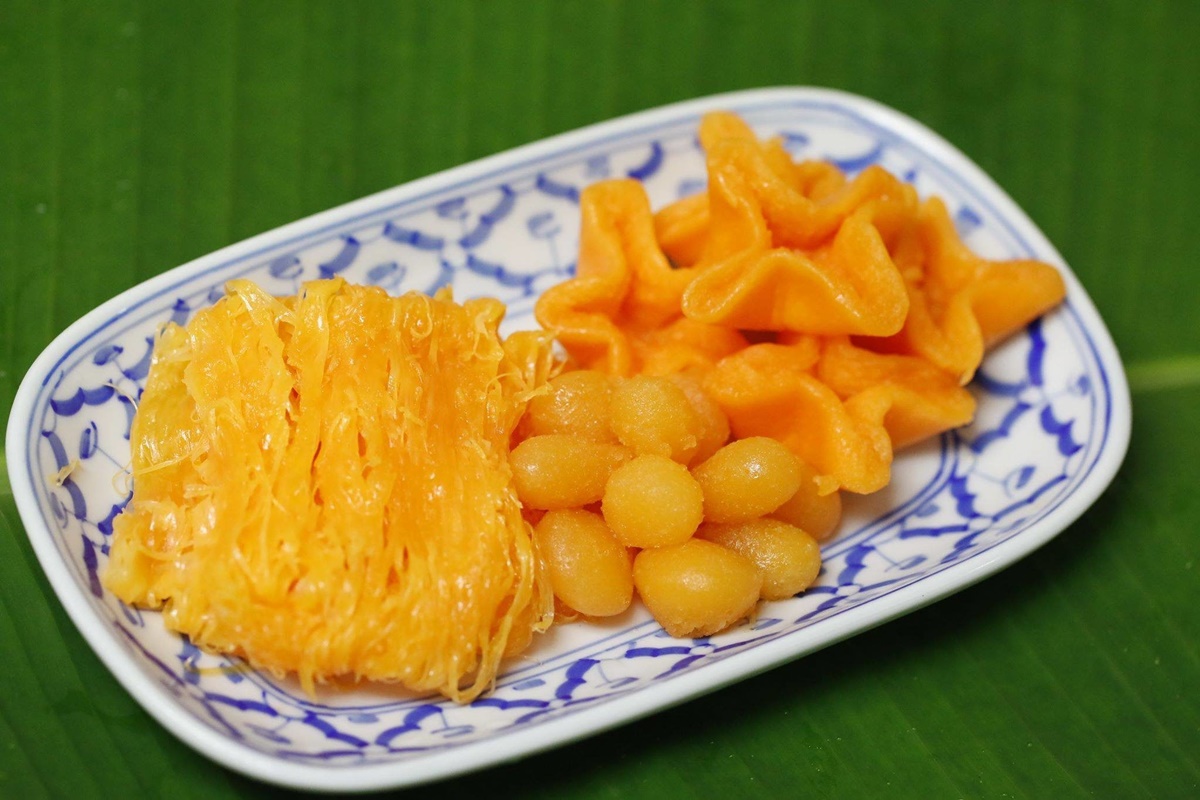
From left to right: foi thong, thing yod, and thing yip [cr. Matichon Academy]
As an international woman, Marie Guimar is in herself a cultural melting pot. She spoke fluent Portuguese and lived near the Portuguese community. Her egg yolk-based sweets, such as Thong Yip (golden flower), Thong Yod (golden droplet), Foi Thong (golden thread), Khanom Mo Kaeng (Thai custard), and many more, were undoubtedly influenced by this European country. Plus, she had a Japanese mother who was familiar with Portuguese cooking. It is also possible that Thao Thong Kip Ma might have inherited her sugary recipes from her. Prior to Guimar, Thai sweets composed mainly of sugar, coconut milk, and rice flour. Eggs were consumed mostly as savory items. Guimar’s use of egg-yolk in making sweets forever changed the face of the Thai confectionary scene.
- Queen Sri Suriyendra
Queen Sri Suriyendra, as mentioned earlier, was the queen consort of King Rama II. A daughter of Princess Sri Sudarak and a Chinese father, Queen Sri Suriyendra or then Princess Bunrot was fluent in Chinese. During the reign of King Taksin, she was appointed as an ambassador on a diplomatic mission China. There, she was well-received by the Qian Long Emperor and was able to bring back many needed ammunitions and construction materials to Siam. Later, she had a romantic relationship with Prince Israsundhorn. When the prince ascended the throne as King Rama II, she became Queen Sri Suriyendra of Siam.
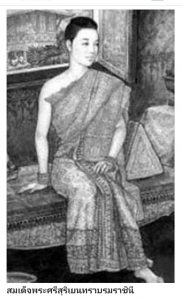
Artistic imagination of Queen Sri Suriyendra [cr. MThai]
Although Queen Sri Suriyendra did not invent any recipes as far as we are aware, her unparalleled cooking skill did inspired King Rama II to compose a poetry lamenting the absence of hers and her cuisine during his long journeys. Acclaimed for the literary beauty and the emotional description of delicate Thai dishes, this poem titled “Kaphae Chom Khrueng Khao Wan” (a poem admiring sweet and savory dishes) was written in the form of Kap Yani Sip Et[2] and Khlong Si Suphap.[3]
This poem describes 14 types of savory dishes and 17 types of sweet dishes. In each dish, King Rama II elaborated the characteristics of the ingredients so vividly that readers can almost smell and taste them all. This was possible because of the queen’s thorough understanding of Thai ingredients and the dishes she prepared, and most importantly her Sanay Plai Chawak. For example,
“มัสมั่นแกงแก้วตา หอมยี่หร่ารสร้อนแรง
ชายใดได้กลืนแกง แรงอยากให้ใฝ่ฝันหา”
Your massaman curry is fragrant with cumin and has a fiery flavor. Any man who has ever tasted this soup would desire you.
“ก้อยกุ้งปรุงประทิ่น วางถึงลิ้นดิ้นแดโดย
รสทิพย์หยิบมาโปรย ฤๅจะเปรียบเทียบทันขวัญ”
Fresh tiny shrimps are seasoned with aromatic spices. As I put them on my tongue, I almost die of its flavor. A heavenly condiment will never turn it into such a heavenly dish as you do.
“ทองหยิบทิพย์เทียมทัด สามหยิบชัดน่าเชยชม
หลงหยิบว่ายาดม ก้มหน้าเมินเขินขวยใจ”
Thong yip is on par with divine food, so adorable with three folds that I pick it up and inhale it. How silly I am!
“ฝอยทองเป็นยองใย เหมือนเส้นไหมไข่ของหวาน
คิดความยามเยาวมาลย์ เย็บชุนใช้ไหมทองจีน”
Foi Thong is sparkling golden like silk made from sweet egg yolks. It reminds me of when you sew with golden Chinese silk.
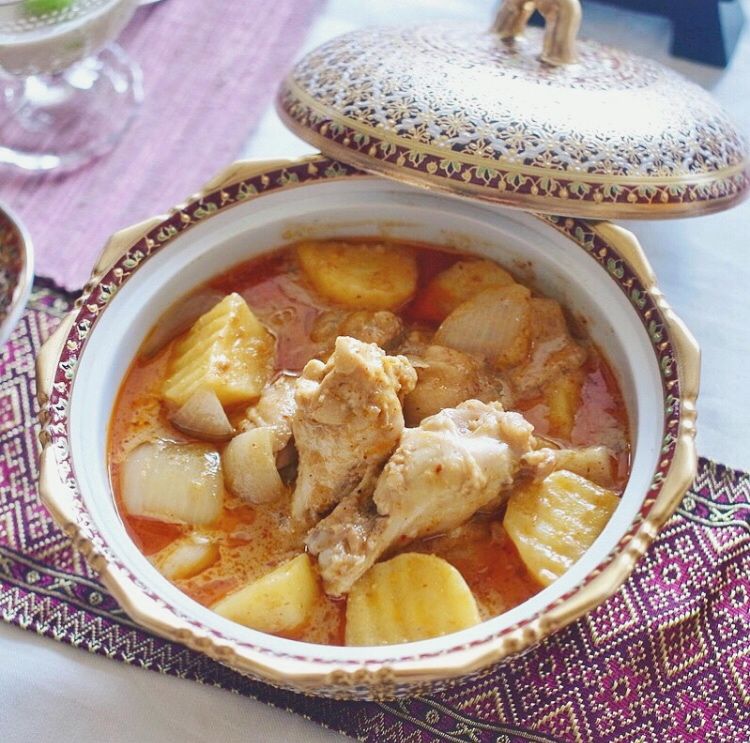
Massaman curry [cr. Pinterest: NitRudy]
Today, the “Kaphae Chom Khrueng Khao Wan” is still being studied for its literary beauty. Historians and cooks also refer to the work to piece together the looks and tastes of ancient royal dishes. None of this would have been possible without the culinary expertise of Queen Sri Suriyendra.
******************
What you have read is some of the contributions from women to the development of Thai food in the classical era. From these early days, we have seen craftsmanship, skill, and creativity from the female food visionaries of Thailand, as well as the traditional gastronomic culture. Be sure to stay tuned for the next chapter on the delicious journey of Thai food and influential women trailblazers.
[1] เพลง “เทพธิดาผ้าซิ่น” ของเสรีย์ รุ่งสว่าง “หากเลือกวัวดูหาง แม้นเลือกนางดูแม่ นั่นแหละแน่เข้าที บ้านเรือนสะอาดตา พูดจาเสนาะดี ตำน้ำพริกทุกที เสียงตำถี่จนทุ่งสะเทือน”
[2] The versification of Kap Yani Sip Et
OO OOA OOA OOB
OO OOB OOO OOC
OO OOD OOD OOC
OO OOC OOO OOO
[3] The versification of Khlong Si Suphap
OOOO1O2 OA (OO)
OO1OOA O1B2
OOO1OA OO1 (OO)
OO1OOB2 O1O2OO
References:
- Thai sum rub
https://www.youtube.com/watch?v=46-vNnRreq8
- Ladies in the Thai court
Thai Gastronomy from Home Kitchen to Royal Cuisine
- Khai Hong dessert
https://www.matichonacademy.com/content/food-story/article_10054
- Abundance of resources and diversity of Thai cuisine
https://www.silpa-mag.com/on-view/article_23294
https://www.youtube.com/watch?v=tj7HQCzJ9uo
- Thao Thong Kip Ma
https://www.silpa-mag.com/history/article_42176
https://www.silpa-mag.com/history/article_16626
https://dbpedia.org/page/Maria_Guyomar_de_Pinha
- Queen Sri Suriyendra
https://sites.google.com/site/krujeanky/wrrnkhdi-laea-wrrnkrrm/kaphy-he-chm-kheruxng-khaw-hwan
Author: Soonyata Mianlamai
Editor: Tayud Mongkolrat
March 25, 2022


